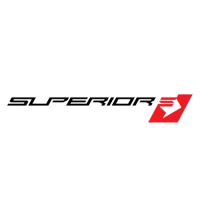Installation & Operation Manual
O-360 and IO-360 Series Engines
2 Chapter 3 • Aircraft / Engine
© March 2004 Superior Air Parts Inc. Integration Considerations
be significantly reduced by increasing duct size
and thereby reducing the air velocity.
Utilizing ducts with circular cross-sections or
“square” cross-sections with the highest possible
aspect ratio can also reduce duct losses.
Turning vanes can be used to reduce losses in
sharp corners when necessary.
The state of the airflow as it enters the
carburetor or fuel injector servo body is critical to
effective and efficient fuel mixing. Both
carburetor and fuel injector servo bodies sense
mass airflow and introduce fuel based on that
measurement. If the airflow is turbulent during
this process, inaccurate airflow sensing can
occur resulting in improper fuel flow. Turbulence
of the intake air in a carbureted system will also
promote poor fuel / air mixing and large cylinder
to cylinder mixture variations. The
consequences of these conditions can be as
simple as reduced power or as great as in-
cylinder detonation.
Care should also be given to the placement of
the intake system with respect to hot areas such
as exhaust pipes and other engine components.
Cooler intake air results in better power output
and greater service ceilings. Intake systems
that allow heating of the air reduce available
engine power and can reduce service ceilings.
B. Intake Air Requirements and Filtration
The intake air and filtration system must be
designed for both effective and efficient filtering
with minimal flow loss. Studies have shown that
particulates greater than about 10 microns in
size are particularly harmful to engines;
therefore the filtration system should be selected
accordingly. Filter manufacturers can provide
data regarding effectiveness, efficiency and
capacity of their products including the effect of
particulate size. Guidance regarding overall filter
size, based on filter capacity, can be obtained
from the filter manufacturer.
The size of the air filter must also consider the
total engine airflow requirements and the
maximum air velocity requirements of the filter.
In general, filters are more effective for lower air
velocities but practical considerations must be
made based on space available. Intake air flow
requirements of a Superior Vantage Engine are
defined in Figure 1 of the Model Specification
Data. It is recommended that the filter be sized
to provide a minimum of 150% of this flow to
minimize pressure drop for both clean and dirty
filters.
C. Carburetor Heat
Due to the cooling effects of both fuel
vaporization and airflow through the venturi,
carburetor ice can form with outdoor air
temperatures as high as 100°F. Therefore, it is
necessary to provide a mechanism to introduce
heat to the intake airstream, downstream of the
air filter, to prevent this condition and to correct it
if icing were to occur. This mechanism also
serves the purpose of an alternate air source
should the filter become unexpectedly blocked
due to ice or debris. The minimum temperature
rise required of the carb heat mechanism is
specified in the FARs.
The design of the carb heat system should, in
general, follow the same guidelines as the
induction air system to minimize pressure loss
and turbulence. For example the flow area
should be as large as possible to reduce air
velocity and therefore flow losses. Relatively
slow-moving air across a heat source will also
experience a higher temperature rise than
faster-moving air over the same heat source.
Good practice suggests that the carb heat duct
should be at least 75% the size of the carburetor
inlet.
The air source for the carb heat mechanism
should be from a source other than the
“standard” filtered intake air. It is common for
the carb heat air to be drawn from within the
lower cowl area. It is also conventional to omit
the use of a traditional air filter at the carb heat
source for several reasons including preventing
the risk of filter blockage for alternate air.
However, it is good practice to include a course
screen to prevent ingestion of “large” foreign
objects.
The carb heat air is normally introduced to the
induction airstream by means of a mixing box.
The mixing box includes a baffle door that is
manually actuated by the pilot and governs the
amount of filtered induction air or carb heat air
that is supplied to the carburetor.

